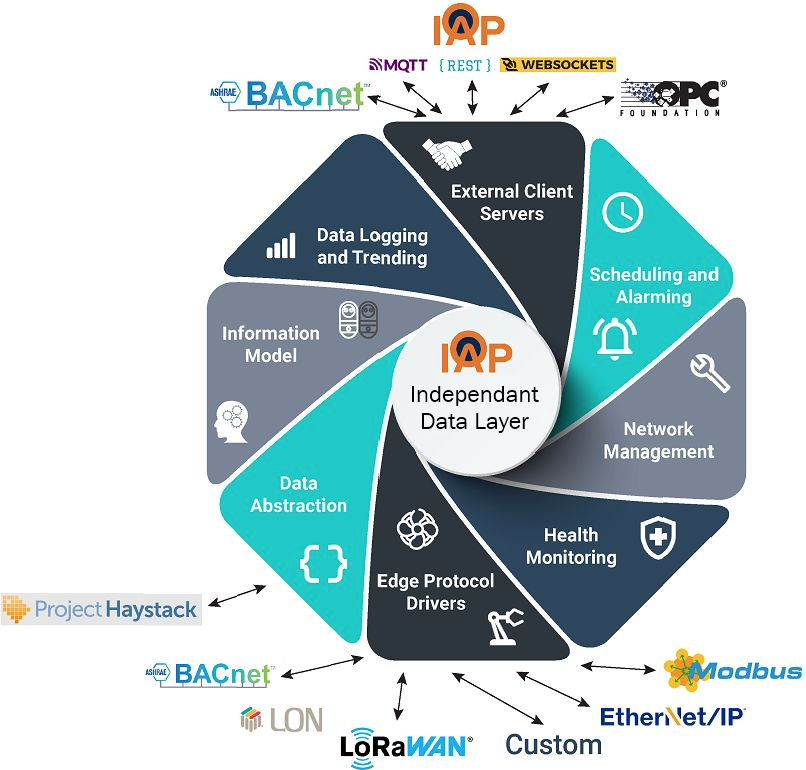

The concept of an Independent Data Layer, or IDL, for Smart Buildings has gained popularity recently and for good reason. The role of an IDL is to make data from existing building systems available to external applications or databases. The data cannot simply be a representation of the building system data but must be a live and interactive dataset. That means the IDL must have the capability to read and write live data from these systems regardless of the underlying protocol(s) used within the building. What makes an IDL “independent” is its ability to exist outside of the existing building system stacks found today. Its purpose is to democratize the data, not to create another closed technology stack.
There are several IDL applications available but the IAP Independent Data Layer stands out in that it is the only edge-deployable independent data layer and is not dependent on cloud rescores.
Let’s talk about what makes the IAP data layer different.
Open Standards
IAP itself is the ANSI/CTA 709.10 open standard. This means that anyone can develop their own IDL solutions using the published standard. This also eliminates vendor and technology lock-in which continues to be a challenge in the ever-changing Smart Building space.
Lives at the EDGE
As mentioned above, the IDL lives within the building at the edge, where the data is generated. Not only does this make it independent from the other building systems, but it remains independent from any software applications or cloud-based IoT solutions. It is owned by the building, and freely accessible to anyone granted access to the data.
Data Abstraction
Data collected by the IDL can originate from different systems using different data formats and protocols. A properly configured IDL must represent that data in a uniform and useable fashion for other systems to work with. This is where the Data Abstraction tools included with IAP go to work. IAP does not create an ontology but creates what the ontologies need to do their job. IAP can structure the data geographically within a building, and with a hierarchy down the individual thermostats. Rich descriptions can be associated with what would otherwise be raw unformatted data.
Built-in Drivers
Multiple embedded drivers within IAP make connections to a variety of different systems significantly easier than performing individual system-to-system integrations. Since IAP is an open standard, custom drivers can be created using the published standard. The included drivers are also bi-directional which is important for interoperability which we discuss next.
Multi-system Interoperability
The IAP data later not only creates a representation of the data but allows live interaction and two-way communication between all data sets. This intersection of data in an IDL creates amazing potential. Imagine being able to leverage lighting control system occupancy data as an input to your HVAC occupancy requirements. Or inputs from a card access system to determine lighting and setpoint requirements for individuals’ needs.
Application Development
The IAP Independent Data Layer creates a rich application development environment at the edge, in the cloud, or both at the same time. Applications need access to data to make decisions and drive additional value for the building occupants and owners. IDL data is available to applications via multiple embedded APIs including REST or MQTT. This creates a seamless edge-to-cloud approach that allows local algorithms to manage critical processes while cloud applications continuously analyze results and modify algorithms continuously.
Embedded Services
An IDL is a living set of constantly changing variables that requires management and oversight. Using the embedded IAP user interface provides access to services such as alarming, device health, network management, and data logging. These provide the tools necessary to configure and manage your data layer to best fit your needs. Each of the embedded services runs using the same API structure as the rest of the data so leveraging them becomes just as easy as subscribing to the data you need.
Independent Data Layers are ready today and gaining adoption but some of the existing building solution providers see the IDL as a threat. Customers today are hanging onto technology they paid for because it is difficult and expensive to change. The fear of having to go through another complex integration just to change solution providers is daunting. If you start with an IDL, the integration only has to be done once and changing solution providers is easy. If anything, this should force solution providers to create better products that building owners want to keep and don’t feel stuck with.
For more information on Independent Data Layers or related topics feel free to get in touch.


